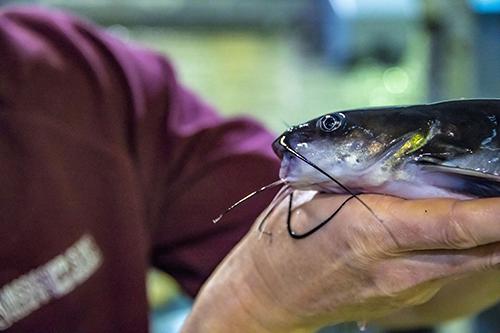MSU takes top spot in ScholarGPS aquaculture rankings
Contact: Meg Henderson
STARKVILLE, Miss.—For the second year in a row, Mississippi State is the best in the world at studying aquaculture, according to ScholarGPS’ global institutional rankings.

One of today’s most robust and comprehensive scholarly analytics platforms, ScholarGPS evaluates institutions by publication productivity, research quality and meaningful impact. It ranked MSU No. 1 in the world for 2024, just as it did for 2023. In 2022, MSU was No. 2.
“Mississippi State University has long been a national and international leader in aquaculture innovation, and we remain committed to working with our many partners to ensure continued success for this vital sector,” MSU President Mark E. Keenum said. “My early professional life here at MSU in the Department of Agricultural Economics and MSU Extension Service was focused on catfish production, and so I have a great appreciation and respect for our faculty who are engaged in this meaningful research and who are also providing our students with exceptional hands-on learning and research opportunities.”
For 2024, ScholarGPS ranked MSU in the top 10 globally in 19 specialty fields, including animal health, ecological engineering, family business, weed control and wildlife management.
Jimmy Avery, an MSU wildlife, fisheries and aquaculture professor who leads the U.S. Department of Agriculture-National Institute of Food and Agriculture’s Southern Regional Aquaculture Center and works with the MSU Thad Cochran National Warmwater Aquaculture Center, explained that specialized categories set ScholarGPS apart from other scholarly databases.
“There are a few other services that evaluate scholarly impact, but ScholarGPS is unique because, rather than ranking scholarship in a broad category such as agriculture or natural resources, it drills down into subcategories, showing the true impact of an institution or even an individual scholar in a field of study,” he said.
Mississippi, the No. 1 catfish producer in the nation, and Washington had the largest contributions to aquaculture in the country, accounting for a combined 29% of the nearly $2 billion in total sales in 2023. Over the last 30 years, Americans’ per capita consumption of fish has grown by 38%, making the aquaculture industry more critical than ever.
In 1980, MSU established the aquaculture research program and laboratory at its Delta Research and Extension Center in Stoneville, located within 50 miles of nearly half of the country’s aquaculture industry. Scientists from MSU and the USDA launched a research hub focused on channel catfish production—the largest sector of U.S. aquaculture. Research areas include nutrition and feeding, production systems, water quality, pond ecology, bioinformatics, genetics and breeding, production economics, fish diseases and fish health management.
Between the Delta center and the university’s main campus, there are 20 faculty members dedicated to aquaculture research and outreach—eight in the Mississippi Agricultural and Forestry Experiment Station, or MAFES, 11 in the College of Veterinary Medicine and one in the MSU Extension Service. Nine additional faculty from other academic departments have contributed to recent aquaculture projects. Each year, the NWAC program maintains approximately eight graduate students studying industry-related issues involving nutrition, production, economics and fish health.
MSU faculty have partnered with USDA scientists for almost 40 years in aquaculture research. In 1987, the USDA Agriculture Research Service established the Catfish Genetics Research Unit to conduct genetics and breeding research. Recently, the USDA-ARS unit was renamed the Warmwater Aquaculture Research Unit to better reflect its expanded research mission. Currently, seven USDA scientists are stationed there. On campus, scientists with the USDA APHIS Wildlife Services National Wildlife Research Center are collaborating with MSU faculty to study avian depredation of aquaculture species.
“Having our USDA colleagues in the same facility allows us to build relationships and work with specialists in all areas affecting aquaculture,” Avery said. “Their collaboration with our faculty has contributed to our university’s successful ranking.”
Beyond scholarly publications, scientists are supporting the aquaculture industry in ways that may be harder to quantify but have a notable impact. Their recent breakthrough ESC vaccine and delivery system have decreased the use of antibiotics and reduced incidence of antibiotic resistance. They have helped the catfish industry achieve a 59%-per-acre increase in production efficiency through improved fish health-management strategies, and they offer regular support and resources to farmers, government agencies and industry leaders.
“Mississippi State has invested in aquaculture research for the last 50 years, building up what is today the country’s largest aquaculture research facility,” Avery said. “It’s that kind of commitment of facilities and faculty that makes our university a leader in this field.”
For more information on the NWAC, visit www.tcnwac.msstate.edu.
Mississippi State University is taking care of what matters. Learn more at www.msstate.edu.